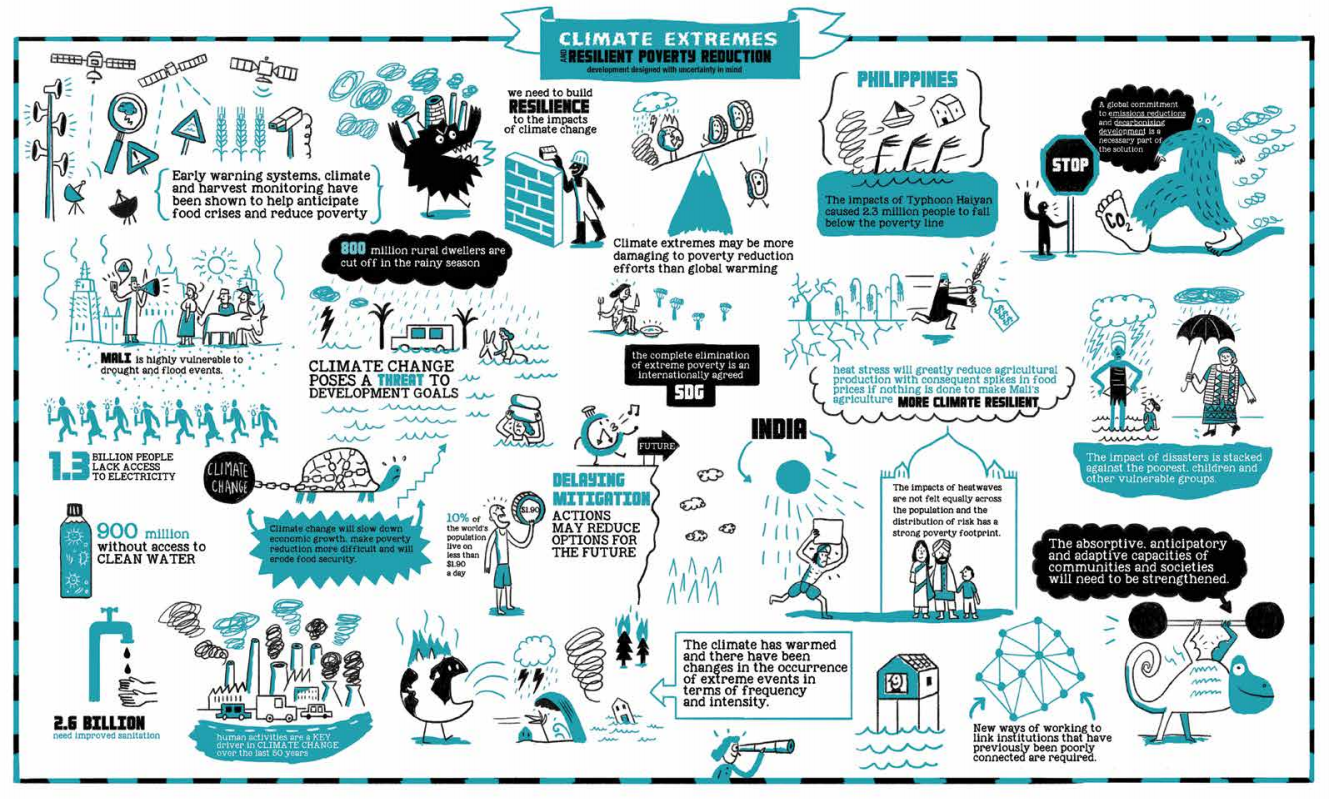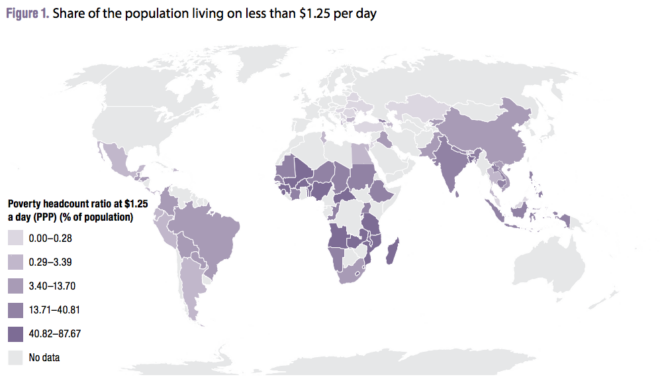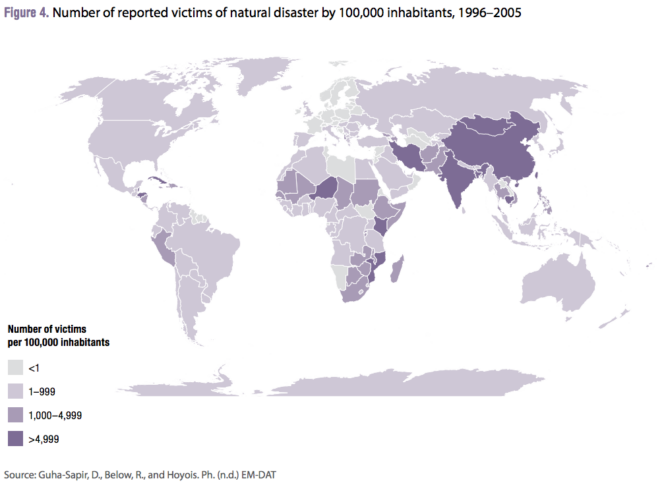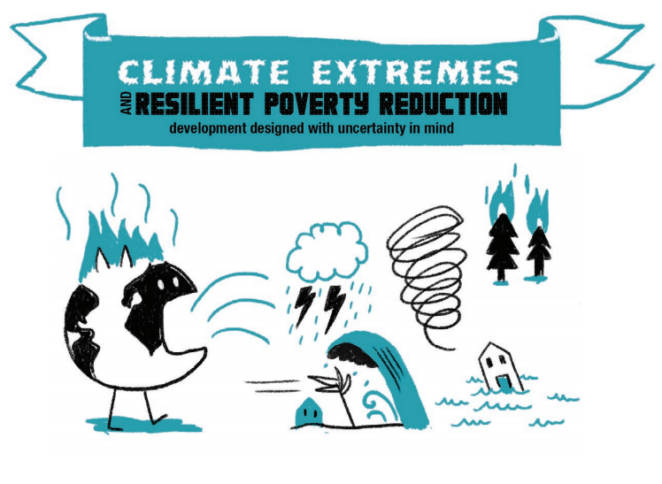Climate extremes and resilient poverty reduction

Introduction
The global climate is warming and there is now growing evidence that climate variability is increasing in many places and climate extremes are becoming more frequent and intense in some parts of the world. Greater seasonal variability and changes in the prevalence and intensity of climate extremes pose serious challenges for poverty reduction in the future, both in terms of impact and the increased uncertainty that intensified climate risk brings.
Building resilience to climate extremes and disasters will help ensure the success of global efforts to eliminate extreme poverty. Reaching and sustaining zero extreme poverty, the first of the SDGs, requires a collective effort to manage the risks of current climate extremes and projected climate change.
This report*explores the relationships between climate change and poverty, focusing on climate extremes, on the basis that these manifestations of climate change will most affect our attempts to reduce poverty over the next 15 to 25 years. Framed by a wider analysis, three detailed studies – on drought risk in Mali, heatwaves in India and typhoons in the Philippines – illustrate the relationship between climate change, climate extremes, disasters and poverty impacts.
*download available from the right-hand column and via the links provided under Further Resources (which include the Executive Summary). The key implications for policly and planning, an overview of the report contents and the key lessons learnt (in brief) are provided below.

Implications for Policy and Planning
This report calls for improved resilience to climate extremes as a requisite for achieving poverty reduction targets. To achieve this, planners and policy makers will need to support the strengthening of the absorptive, anticipatory and adaptive capacities of communities and societies. New ways of working are required to link institutions that have previously been poorly connected, with new criteria for decision-making, such as considering the best solutions across different possible climate futures. The scale of the challenge suggests more transformative actions may be necessary, including through the use of new risk financing mechanisms.
Build adaptive, anticipatory and absorptive capacity:Tackling the combined challenges of poverty eradication and climate change requires action to increase the resilience of communities and societies most vulnerable to increasing climate risks. Capacity at the local level shapes how impacts of extremes play out and affect patterns of poverty. By building the anticipatory, absorptive and adaptive capacities of those communities and societies most vulnerable to increasing climate risks, we can minimise the impact of climate extremes on poverty levels and the poor.
Strengthen institutions, across scales: Continued investment in local disaster risk management capacities and institutions is required, as well as efforts to strengthen coordination across different levels of governance. Decentralisation that provides greater decision-making authority can help empower local institutions and, when coupled with efforts to integrate local units within national and regional planning systems, can produce more effective local solutions to the risks posed by climate extremes.
Think globally, but assess risk locally: While regional and global assessments are essential for understanding the scope of the climate challenge, local diagnosis is needed to provide a more accurate understanding of how risk is distributed. Analysis that connects macro-to-micro-scales, drawing on the comparative strengths offered at each level of analysis, will present a more nuanced and accurate picture of the climate change-disaster-poverty nexus.
Link institutions and solutions: Solutions that strengthen resilience and reduce poverty will need to link different institutions that have previously been poorly connected. Analysis of the relationship between climate change, disaster and poverty reveals some important gaps in connectivity and coordination across fields of policy and practice. More joined up ways of working across sectors and scales may be required, using climate and weather information, along with scenarios to inform planning.
The role of transformative action: Building resilience capacities incrementally may not be enough to secure poverty reduction in the face of climate change. The scale and scope of future climate risks will require a transformational shift in the way risk is managed. Transformational changes can be catalytic in nature, leveraging change beyond the initial direct activities. They achieve change at scale, with outcomes of a high order of magnitude relative to resource inputs, or can be sustainable over time, outlasting initial political and/or financial support.
Finance as a catalyst for transformation: Risk financing instruments have the potential to generate transformational changes by acting as a catalyst for further investment in disaster risk management and adaptation. Regional financing mechanisms can also help countries to scale up these investments in places where they are most needed. Finance is not a panacea and has limitations in some developing contexts, but it can and does offer opportunities for new ways to manage risk that warrant further attention as part of a portfolio of solutions.

In the report
Chapter 1 presents the challenge of eliminating extreme poverty by 2030 and highlights some of the key mechanisms through which climate extremes lead to disasters, as well as evidence on the links between climate change and development and poverty.
Chapter 2 focuses on three types of events where there is clearest evidence of changes in terms of the magnitude, frequency and variability of climate phenomena: climate variability and extremes in the Sahel, storm surges in the Philippines and heatwaves in India. We demonstrate how what was once considered extreme has, in some parts of the world, become increasingly common.
In chapters 3–5, we examine patterns of extreme events, exposure and vulnerability in each of the case studies from those three regions and analyse some of the poverty impacts of recent events. We review existing policies to manage climate change risks and assess the adequacy of these, given projections of climate extremes. Through the case studies, we see that disasters clearly have a disproportional impact on the poor because of their exposure and vulnerability to different types of climate extremes. However, the story is more complex at the local level and impacts are not just felt in the places where these extremes occur. The report suggests that the idea of poverty and climate extreme hotspots may be erroneous and more attention needs to be paid to understanding how different groups are vulnerable in order to build resilience capacities.
Chapter 6 discusses principles, planning and policy tools for building resilience in the face of uncertainty. The chapter discusses how solutions will need to link different institutions, prioritise new criteria in decision-making and be flexible in light of different possible climate futures.
Chapter 7 outlines tools and lessons that planners and policy makers need to incorporate in order to accommodate climate extremes in order to achieve resilient poverty reduction. It does so through a set of principles for building resilience. Building on case study findings, it concludes that tackling the combined challenges of poverty eradication and climate risk will require joint action aimed at promoting development, reducing vulnerability to climate extremes and managing exposure to those risks.

Key findings from the report (in brief)
Climate extremes are an increasing problem:Our climate has warmed in the past 50 years (IPCC, 2014a) and patterns of extreme events have also shifted (IPCC, 2012). Overall, we have seen extreme events, like those experienced recently in Mali, India and the Philippines, becoming more frequent. As climate change continues, especially if we exceed a 2o C global mean temperature increase, these changes in extremes will become increasingly difficult to manage in a growing number of places. Changes in climate extremes need to be studied at the local level, as what is considered ‘extreme’ occurs in relation to what is ‘normal’ in a specific context.
Climate extremes have multiple poverty impacts across scales: The impact on poverty and the multiple effects disasters have on the poor themselves may collectively be more damaging to poverty reduction efforts than increasing average temperatures alone, at least over the next 30 years.
Poverty is dynamic and there is strong evidence to suggest millions move in and out of it every day. This is due to abrupt changes in levels of consumption brought about by different shocks and stresses, of which climate extremes are just one kind. In all three case studies, climate extremes are seen to affect the poor because of their high levels of exposure and vulnerability. For all three types of events, we see a disproportionate impact on those who live below the poverty line and suffer from non-income dimensions of poverty, such as poor housing. We also see a range of types of impacts on the poor, including those felt directly by the household, those that are indirect and via development impacts, and effects that are short- and longer-term.
Indirect impacts of climate extremes are felt not only by poor households living in affected areas but also by those in other parts of the country, through knock-on effects. These are transmitted through a number of different mechanisms, including drops in productivity and economic growth, along with loss of government assets, service disruption and the diversion of government spending to response activities. Nevertheless, income distribution and inequality are crucial to impacts. National development indicators do not always reflect the severe consequences of disaster for the poorest members of society and care needs to be taken in interpreting impacts at this level.
There is no simple co-location of climate extremes and poverty: This report demonstrates that the relationship between poverty and climate extremes is complex and there is no simple co-location of these two phenomena. Whether or not these phenomena interact spatially and create ‘hotspots’, around which to target interventions, depends on a number of factors. These include the type of climate extreme, location of the event and the type of impact (and hence how impact is transmitted).
Risk from climate extremes is increasing: This report highlights some parts of the world where patterns of extreme events are changing and risk is rising. Although climate science is improving and is better able to clarify climate change’s contribution to extreme events at the global scale, it is not always clear what local patterns of rainfall, temperature or hazards will look like over the next 15-25 years, let alone the second half of the century. Nonetheless, it is likely that more poor people will be exposed to the changes that do occur. People’s exposure is already changing as a result of wider trends, such as population growth and urbanisation. Problems are created by natural resource depletion, including deforestation and the destruction of mangroves on the coast, which provide natural protection against cyclones, storm surge and sea level rise.
Suggested citation:
Wilkinson, E. and Peters, K. (Eds.) (2015) Climate extremes and resilient poverty reduction: development designed with uncertainty in mind. Overseas Development Institute, London.
(0) Comments
There is no content